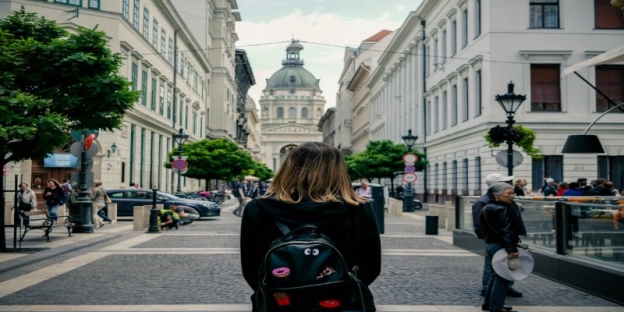tech
Live Calls in Business: Understanding Real-Time Communication
1756804167000
Ever wondered if you can explore Europe on a budget? Yes, it's possible. You don't need to be rich to see world-famous cities, enjoy delicious local food, or ride scenic trains. Here's how to travel Europe on a daily budget of just $50.
Ever wondered if you can explore Europe on a budget? Yes, it's possible. You don't need to be rich to see world-famous cities, enjoy delicious local food, or ride scenic trains. Here's how to travel Europe on a daily budget of just $50.
Most people assume Europe is expensive. But that depends entirely on how you travel. If you're thinking of luxury hotels and fine dining every night, $50 won't suffice. But if you're open to practical choices—hostels, local eateries, and public transport—you'll be surprised how far that $50 can stretch.

Eastern and Central Europe offer the best value. Countries like Hungary, Poland, Romania, Bulgaria, and even parts of Portugal and Spain still let you live well on a tight budget. Even in pricier cities like Paris or Amsterdam, you can bring costs down by knowing where to save and where to spend.
The goal is to keep daily travel costs under $50 while still enjoying your trip. On average, you'll want to split your budget roughly like this:
Accommodation – $15–$20
Food – $10–$15
Transport and Attractions – $10–$15
You’ll need to plan smart, but there’s plenty of room to enjoy yourself.
Forget hotels. Hostels, guesthouses, and short-term rentals are your best bet. Hostel dorm beds often range from $10 to $20 per night across much of Eastern Europe. Even in Western Europe, you can find options under $30 if you book in advance or use trusted hostel platforms.
In some cities, university dorms are converted into hostels during summer breaks, offering affordable accommodations. Couchsurfing is another option—it's free and provides a local experience. But always choose verified hosts with reviews.
Another affordable route is house-sitting. If you're flexible with your travel dates and locations, you could stay in someone’s home for free in exchange for looking after their pets or plants.
Eating well on a budget in Europe is more doable than you think. Local bakeries, street food stalls, and supermarket delis offer authentic and affordable European-style meals. In places like Berlin or Lisbon, you can find filling street food for under $5.
Many European cities have local markets—perfect spots to pick up fresh produce, bread, and snacks. If your hostel or Airbnb has a kitchen, cooking your meals occasionally helps stretch your budget.
When dining out, look for lunch specials or "menu of the day" deals. These fixed-price menus are typical in Spain, France, and Italy. They usually include two or three courses and a drink for $10 to $15.
Transportation is one of the most significant expenses associated with travel. But there are many ways to save.
Budget bus companies, such as FlixBus or BlaBlaCar Bus, offer long-distance routes between cities for under $20. If you plan to take multiple train rides, consider purchasing a regional rail pass. For example, the Balkan Flexi Pass is more affordable than the well-known Eurail Pass and still covers several countries.
For shorter trips within cities, consider walking or using local transit. Most European cities have excellent and affordable public transport systems. A daily ticket typically costs under $5 and provides access to buses, metros, and trams.
Carpooling with locals through services like BlaBlaCar is another way to save money and meet people. It’s often faster and cheaper than trains or buses, especially in countries like France or Germany.
You don't need a big budget to enjoy what Europe has to offer. Many museums and attractions offer free entry on specific days each week or month. In cities like London, many top museums are always free of charge.
Public parks, walking tours, city viewpoints, and historic neighbourhoods don't cost a thing. Check if your destination offers free walking tours—just tip the guide what you can.
Nature is free, too. Hike in the Tatras of Slovakia or swim in the lakes of Croatia. Visit coastal villages in Portugal or explore small medieval towns in Romania without paying an entry fee.
Churches, cathedrals, and open-air festivals are part of daily life in many places. Just walking around with an observant eye can be rewarding.
Keeping your daily budget on track takes a little effort. Use free apps like Trail Wallet or TravelSpend to track your expenses in real-time. Set a daily limit and receive notifications if you exceed it.

Always carry a reusable water bottle. Tap water is drinkable in most of Europe, and avoiding bottled drinks can save a few dollars every day. Bring a light grocery bag, so you don’t have to pay for plastic ones in stores.
Wi-Fi is widely available, but having an eSIM or local SIM card can help with maps and bookings while you're on the move. Staying connected enables you to check transportation schedules, discover restaurant deals, and avoid unnecessary expenses.
Some countries make it much easier to travel on a $50 budget. Here are a few where your money stretches the furthest:
Great food, historic cities, and low-cost transport.
Castles, countryside, and cheap train travel.
Black Sea coast, mountain towns, and very low prices.
Lively cities and affordable meals.
Coastal charm with off-season bargains.
While Western Europe is more expensive, you can still find affordable experiences in cities like Porto, Seville, or Naples.
Skip airport taxis—they’re always expensive. Use public transit or shared rides instead.
Avoid eating or staying near tourist landmarks. Prices are often inflated. Walk a few blocks away and you’ll find better value.
Don't rely solely on big hotels or travel sites. They may not show hostels or small guesthouses that are cheaper and often more authentic.
Avoid exchanging money at airports or train stations. Use ATMs or online exchange services to get better rates.
Travelling through Europe on a daily budget of $50 is possible. You'll still enjoy a great meal, see iconic sites, and meet incredible people. It just means planning, being smart with your choices, and focusing on what matters most—experiences, not expenses. With a bit of creativity and flexibility, you can turn that $50 a day into memories that last a lifetime.